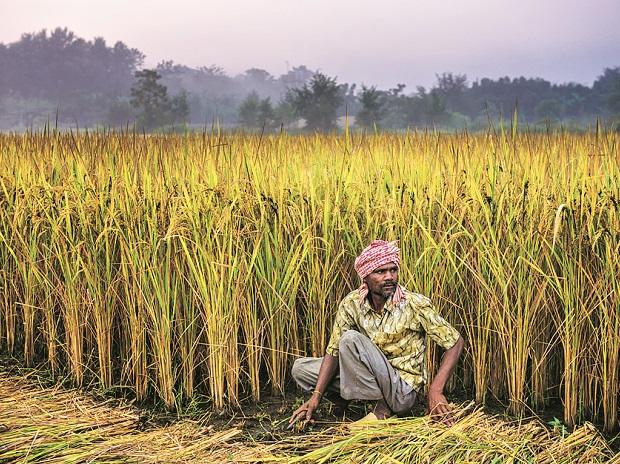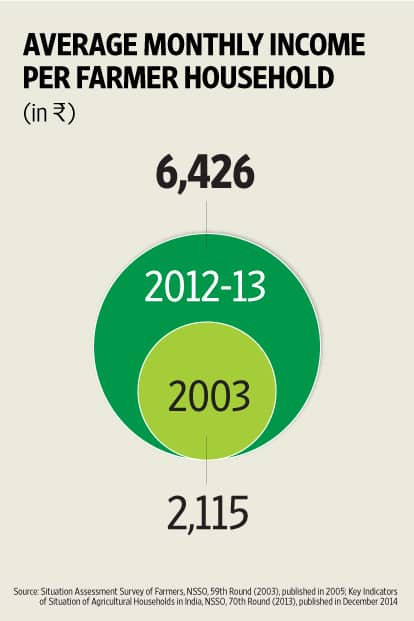Ravi’s wife Yadamma now works as a farm labourer to support her sons. (Source: Harsha Vadlamani)
On the night of July 4, Korishala Ravi stepped out of his house that is right across a branch of the State Bank of Hyderabad in Kodakandla village of Medak district in Telangana. The 35-year-old farmer had applied for a loan to the branch three times but his plea was rejected each time, forcing him to turn to moneylenders. Few hours later, not too far away from the bank branch, he was found dead, his body hanging from a tree.
Ravi’s village is part of Telangana Chief Minister K Chandrasekhara Rao’s Gajwale constituency. Rao had identified it to be developed as a model village.
On September 23, Polu Rajaiah, a 48-year-old landless farmer of Thotapalli village in Karimnagar district, got himself a hair cut and asked his wife to make his favourite curry. After lunch, he went to their field about one km away, drank pesticide and died. Rajaiah had been borrowing money, first to take two acres on lease, then another four acres, and to purchase seeds and fertilisers, but his maize crop had failed, leaving
him with a debt of Rs 3 lakh.
Since Rao took over as the chief minister on June 2, there have been 79 farmer deaths officially recognised as ‘suicides’ in the newly formed state. Beera Ramulu, a farmer and RTI activist associated with NGO Rythu Swarajya Vedika, puts the number at more than 300. Most of these farmers died in Warangal (83), Karimnagar (40) and Medak (70) districts. However, Agriculture Minister P Srinivas Reddy says not all farmer suicides are related to crops.
Like most of the others, Rajaiah and Ravi were both tenant farmers, and they did not fit anywhere in the system designed to help and protect farmers — be it loan eligibility cards, crop loans, easy bank credit, farm-loan waiver scheme or agriculture subsidies — as they had no land to show as collateral. That left them at the mercy of moneylenders charging interest rates as high as 24 per cent per annum. Now their families have to prove the deaths were solely linked to their crops to be entitled to ex-gratia — another uphill battle.
On November 13, the RBI issued a circular to all banks on financing ‘Bhoomi heen kisan (landless farmers)’, as per an announcement in the Budget. Under it, landless farmers can form ‘Joint Liability Groups’ and avail of loans through NABARD for farm and non-farm activities, standing as guarantors for each other. The measure, it is believed, would go a long way towards resolving denial of loans to landless farmers. Union Agriculture Minister Radha Mohan Singh has proposed financing at least 5 lakh joint farming groups this financial year.
Ravi’s brother Balanarasimha, a taxi driver, says Ravi’s loan applications were rejected because he didn’t own any land to show as collateral. “They asked for land ownership documents first to even consider the application,” he says. Ravi had taken five acres on lease to grow cotton, maize and paddy, of which two acres belonged to a relative who had already taken a loan on the land. The owner of the remaining three acres refused to give him a lease agreement, which would have made Ravi eligible for loan. State Bank of Hyderabad Kodakandla Branch Manager Sheikh Abdul Kareem says, “Farmers seeking loans have to give us a copy of the land title in his name, or, in case of tenants, a copy of the lease agreement signed by the owner. We cannot give loans if the documents are not clear or there is a dispute regarding ownership.” The Korakandla branch caters to nine nearby villages, with at least 7,000 farmers. Since January, it has given 500 new crop loans and rescheduled 700 old loans under the Telangana government’s crop loan waiver scheme, but the amount of loan given is very small. For cotton crop, it is Rs 20,000 while for paddy, it is Rs 18,000 per season. The Telangana Rashtra Samiti (TRS) government in the state had announced a Rs 17,000 crore farm loan waiver scheme, to fulfill its poll promise. Under the scheme, outstanding amounts as on March 31, 2014 on crop loans up to Rs one lakh are waived off. This rescheduling of loans makes farmers eligible for fresh loans. The government order issued on August 13, however, clearly stated that the scheme covers only institutional loans and not loans from non-institutional sources. Ravi also tried to get a loan from Telangana Scheduled Castes Cooperative Finance Corporation Ltd through the bank, but the policy is still under discussion. Managing Director of the corporation B Jayaraj says once the budget is passed in the Assembly, the government will decide the loan and subsidy ratio. Admitting a “few inherent deficiencies”, State Bank of Hyderabad General Manager J Sitapathy Sarma says, “Denial of loans to landless farmers is a major issue and needs a change of policy which will make them eligible even if they are unable to show collateral.” He, however, insists that farmers must make an effort to at least get a loan eligibility certificate from the village or mandal revenue officer. The State Bank of Hyderabad is the convener of the State-Level Bankers’ Committee (SLBC). Meanwhile, in order to meet their 18 per cent target fixed for farm loans, banks classify all kinds of loans under the agriculture sector. For example, the SLBC said in July that banks in Telangana had given Rs 49,564 crore loans to the agriculture sector in 2013-14. But when the state government sought details of the accounts of individual farmers who were given loans, SLBC revised the figure to Rs 12,000 crore on March 31, 2014. Banks were apparently also bunching agricultural loans with those taken by farmers for jewellery, marriages, and other non-farm expenses. There are many examples of farmers taking loans for digging or repairing bore wells and paying children’s fees. When crops fail, all these add to their loan burden. “Thousands of farmers are caught in a vicious cycle of debts due to low yields or total crop failure. There is constant pressure from moneylenders and when it does not rain and crops start failing, all they can think of is escaping it by taking their own lives,” says activist Beera Ramulu. TRS politburo member and Karimnagar MP B Vinod Kumar admits the plight of landless farmers who take land on lease. “We need far-reaching reforms in the lending process to include landless farmers in the credit system. In 2010-11, banks introduced business correspondents in villages to make the process of giving loans easier but the correspondents recommend only those who have something to mortgage,” Kumar says. With no options, Ravi had borrowed money from relatives and other villagers at 24 per cent per annum. Documents show he took two loans at 18 per cent interest each, to pay Rs 50,000 upfront to take five acres on lease, and two loans at 24 per cent interest each. “The yield of the maize crop was not good due to inadequate rainfall. The paddy also failed,” says Ravi’s brother. Ravi’s wife Yadamma now works as farm labour, earning Rs 100 a day to support her sons Shiva and Sai. Rajaiah never thought of approaching a bank although three — Andhra Bank, State Bank of Hyderabad and UCO Bank — have branches in Husnabad, 25 km from his Thotapalli village. “We don’t own even a small piece of land, bank officials do not even look at your application. He did not get the loan eligibility card so there was no point going to the bank,” his wife Komaramma says. In 2011, the AP Government introduced a system of giving loan eligibility cards to tenant farmers. Village Revenue Officers, tehsildars, Mandal Revenue Officers could issue the card to a tenant farmer after ascertaining that farming is his only profession, is a genuine farmer, and has taken land on lease. In the presence of the village sarpanch and witnesses, a gram sabha is held and the farmer is given the eligibility card. “But revenue officials are wary of giving the eligibility cards fearing that they will be held accountable if the farmer fails to repay although the government order states that it is not the responsibility of government officials. When officials verify and find that the farmer has some outstanding loan already, they don’t issue the card. This way the system has slowly stopped working and very few cards are given,’’ says RTI activist and member of Rythu Swaraj Vedika Kondal Reddy. In Mallampalli village of Mulug Mandal in Warangal, Merugu Achala, 21, works up to eight hours in a cotton field for Rs 100-130 per day. Her husband killed himself recently over pressure from moneylenders after their cotton crop failed. Achala borrowed Rs 15,000 recently to pay the school fees of her daughter and son, in Class I and kindergarten respectively. The loan outstanding in her husband’s name is already around Rs 1 lakh, but Achala is determined to keep her children in a private school. “My husband did not want them to work in the fields and wished they got proper jobs when they grew up. I too don’t want them to ever work in agriculture,” she says. – See more at: http://indianexpress.com/article/india/india-others/in-telangana-caught-between-life-and-debt/4/#sthash.CXKQ5uO9.dpuf

 @jitendrachoube1
@jitendrachoube1 










